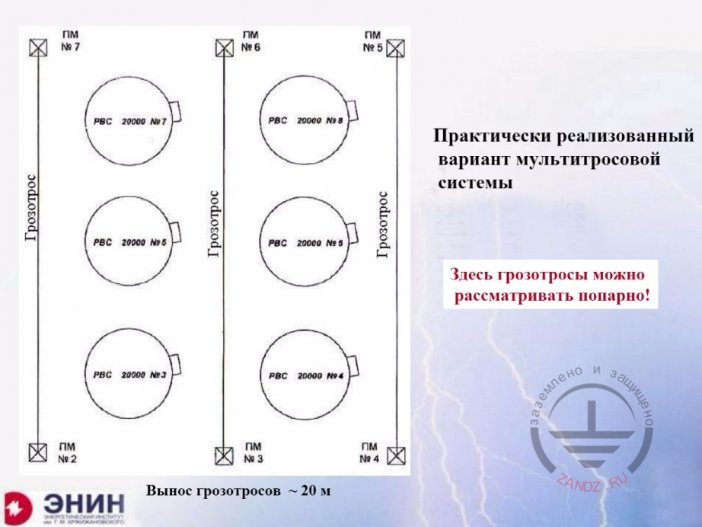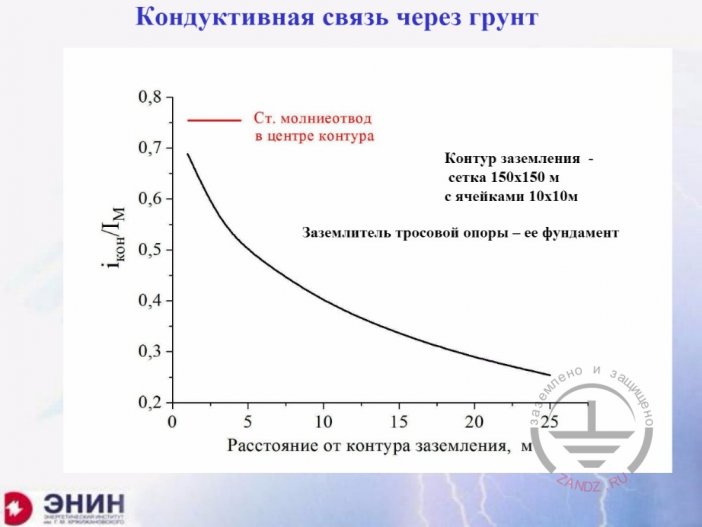The fifteenth webinar of a series "Grounding and lightning protection: issues and problems arising in the design"
Webinar text. Page 2
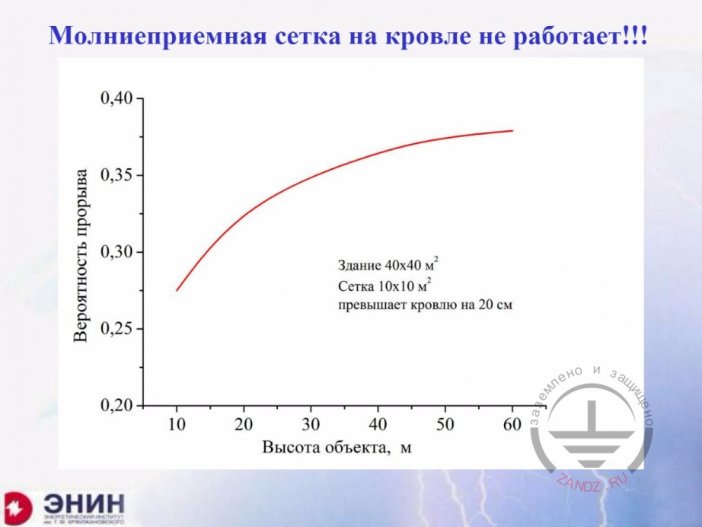
Lightning protection mesh of the roof
Вероятность прорыва- breakthrough probability
Здание - building
Сетка - mesh
Превышает кровлю на 20 см- elevated above the roof to 20 cm
Высота объекта, м – object height, m
- And what do you use? If to talk about building roof protection, then our recommendations give a chance to use lightning protection mesh which is mounted on the building roof. You won't find any mentioning of catenary wire lightning rods, but you will find mentioning of a mesh which is put on the building roof. And this recommendation is very bad and very unreliable, if you put mesh on the building rood, then its protective action will be equal almost to zero, because, if to take a building of typical sizes, say 40*40 and the height of from 10 to 60 meters, then the efficiency of this mesh will be as follows. Have a look, for example, for a 20-storeyed building about 40% of lightning will ignore this mesh and hit the unprotected roof.
- Is there an unprotected zone in the centre of the area?
- Great question. Can I finish a couple of words about the mesh and will answer. The mesh doesn't protect from anything, even in case if it is put above the heat-insulation coating, as it is recommended in AD-34 for flammable coating. Protective effect of the mesh put on reinforce-concrete coating is almost equal to zero. The mesh protects only dielectric roofs and the equipment on the upper levels under this dielectric coating. Now about holes in the protection zones of a closed catenary wire lightning rod. Are there any there?
- Is it possible to put a tape instead of a circle on the roof?
- Instead of what? You can make a catenary wire of anything. The cross section of the wire material has no significance. Whether you make it flat, or in the form of a tape, it makes no difference. I can give you an example so you understand what I mean.
- Not a wire from the circle, but mesh from the tape.
- You know you can make mesh out of anything, its efficiency was and remains zero. The mesh won't be zero only in one case, if you raise this mesh above the surface you are going to protect. Imagine such a situation: building, freezing machines and climate-control machines were put on the roof. You are making a mesh above these machines; raise it to several meters above the roof. Now it will protect machines. And we will study such a recommendation in more detail at the next seminar, which will be dedicated to this topic. But I will move on to the catenary wires.
Multi-rod system variant
Грозотрос - ground wire
Вынос грозотроса 20 м- ground wire rise ~20 m
Практически реализованный вариант мультитросовой системы- practically implemented variant of multi-wire system
Здесь грозотросы можно рассматривать попарно – ground wires can be viewed in pairs here
What you see is a fragment of a document on which lightning protection of one of large reservoir parks was developed. The circles here are 20000 tanks and these tanks are protected with two, three wires. Here is wire 1, 2 and 3. There is no closed project and no lateral wire here. There are wires, three parallel wires. Why there are no intersections here? For the reason, because the wires are carried outside the tank park. They are longer then the territory of the park. And it was quite enough to get rid of lateral wires. The protection reliability of this territory of the tank part turned out to be higher, than 0,99. And it is a real project which was used for lightning protection of one of oil transfer pumping stations. It's not obligatory to make a lateral wire, but it is important for the wires to go outside the protected territory. And according to my estimations, they should be about 20 meters. And the span of the wires here in the studied situation may be 40-50 meters. Now I want to talk about the following.
- in the design rates 22-02-07 of the Ministry of Defence of the Russian Federation "Rates on design of lightning protection objects of the Ministry of Defence of the Russian Federation", the calculation of lightning protection is held with the help of protection angle. Are these calculations more precise than the calculations according to AD and IS?
- You know, this document was never subject to an open discussion. The use of protection angle is in fact copied from IEC standard, but if you open the explanatory note written by the authors of the project, they will state that determination of protection zones on the protection angle was made on the base of the experiments held by the team of Vasiliy MIkhailovich Kuprienko, doctor of technical sciences at a laboratory stand.
Conductive connection through the ground. Part 1
Молниеотвод в центре контура- lightning rod in the center of the contour
Контур заземления – grounding contour
Сетка с ячейками – mesh with cells
Заземлитель тросовой опоры -ее фундамент- catenary wire support ground electrode is its foundation
Расстояние от контура заземления, м – distance to the grounding contour, m
- Now the most important question, today there are not many situations when lightning hits and damages some equipment. All the recent accidents, as a rule, are connected with the damage of automation control circuits and information transfer circuits. And it is very important what is done with the current which lightning rod takes upon itself? This talk about catenary wire lightning rods is very important. Take a rod lightning rod. It will probably stand very close to the projected object; otherwise the object won't be inside the protection zone. It means, the lightning current, which flows from the lightning rod ground electrode, will go very close from the object grounding contour and will probably get into it. Of course it is possible to move catenary wire lightning rod, but if you move it, you will have to raise its height, so the object is within the protection zone. It doesn't happen with catenary wire lightning rods for such a reason.
- See slide 10, I can move the supports of the lightning rod here and move the ground electrodes of these supports from the ground electrodes of the tanks, like in this example. And in the result, lightning current, which a catenary wire will take upon itself and which will finally get into the ground electrode at the supports, the small part of it will get into the object's ground electrode system.
- I am showing slide 11, how it looks for this example. Rod lightning rod, about 75% of current gets into the ground electrode system of the object. Now I take a catenary wire lightning rod and start to move the support from the protected object. If I move it to 20 meters, then only 30% of lightning current will get into the ground electrode of the object. The rest current will flow over the free surface and won't get into the ground electrode system.
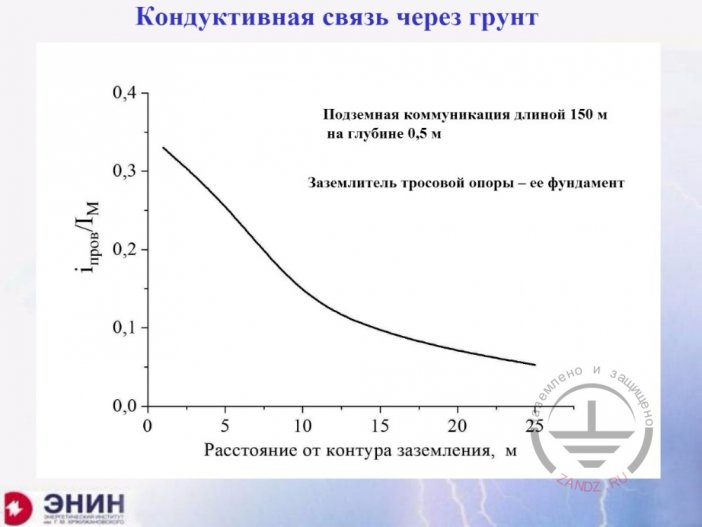
Conductive connection through the ground. Part 2
Подземные коммуникации длиной 150 м на глубине 0,5 м - underground utilities 150 m long 0,5 m deep
Заземлитель тросовой опоры – ее фундамент – Ground electrode of the catenary wire support is its foundation
Расстояние от контура заземления, м – distance from the grounding contour, m
- If I do the same, but for the utilities, for example a cable channel, it runs at the distance from the ground electrode of the catenary wire lightning rod, if I move it to 20 meters, then only 5% of lightning current will get into this utility. That means my utilities and object's ground electrode system will practically work in favourable conditions. They won't be subject to lightning current impact, and it means, there will be no conductive pickup in the circuits, which are located around the object. It means, step voltage will be low and it means touch voltage will be low too. It means the questions of electric safety will be solved and this is a crucial moment. If possible, please repeat the question.
- Is the distance from the catenary wire to the protected object, where the wire is located above the protected object, standardized?
- I got it, you don't have to continue.
- Lightning protection and electric installations ground electrodes should be connected according to EIC?
- Lightning protection ground electrode systems must be connected to the object ground electrode systems only in case if you don't use free-standing structures. The wire is a separately standing structure and there is no contradiction here because EIC states:" as a rule, they should be connected". And catenary wire lightning rod is a very useful exception from this rule and the ground electrode of a catenary wire lightning rode will never connected to the ground electrode of the object. Let me repeat, there is no contradiction in EIC for a simple reason: the saving word "as a rule" gives a chance to do that.
- Minimal cross-section of a lightning rod (steel) should be not less than 50 square mm, cross-section of the wire should also be 50 mm?
- I am not ready to answer this question because I did not check this situation. The wire cross-section as a rule is chosen not according to the capacity of lightning current, it is chosen according to the mechanic loads, which influence the wire - wind load, ice load, if it is a region with ice-covered ground. As a rule, the catenary wire radius is not larger than 1 cm, if you take the radius of 1 cm, your cross section will be about 3 cm2 or 300 mm2. Your 50mm2 will always fit well. I don't know a case, when the wire cross section should be chosen according to the flow capacity. Conditions on mechanic loads are more strict.
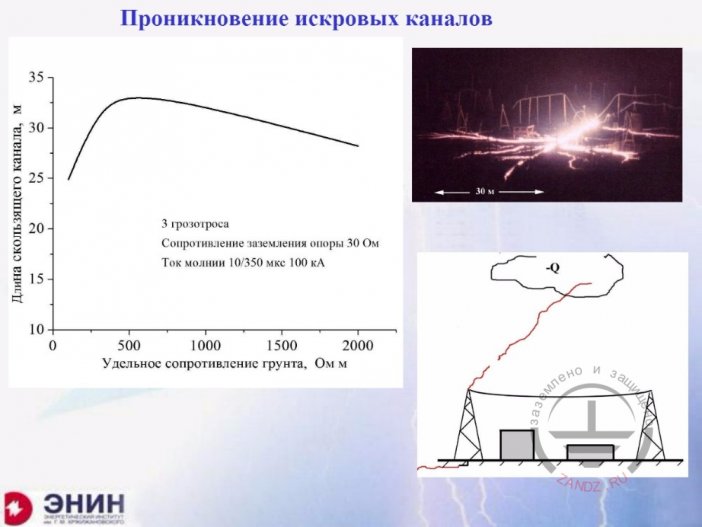
Penetration of spark channels
Длина скользящего канала, м- sliding channel length ,m
3 грозотроса – 3 ground wires
Сопротивление заземления опоры 30 Ом- support grounding resistance is 30 Ohm
Ток молнии 10/350 мкс 100 кА – Lighting current 10/350 ms 100 kA
Удельное сопротивление грунта, Ом м – Ground resistivity , Ohm*m
- I'd like to move on in this direction. I am very worried if the current from the moved support of a catenary wire lightning rod can penetrate inside the grounding contour of the protected object in some way. There is another opportunity about which we talked at one of the seminars - possibility of development of spark channels on the ground surface, which come out from the lightning rod ground electrode system, slide along the surface, run to the dozens of meters in different grounds and get where they should not get. I gave an example of calculation of such spark channels for a typical ground electrode of a catenary wire lightning rod and saw that the length of such a channel may achieve 35 meters at the most favourable conditions. And my recommendation - move it to 20 meters and everything will be ok, though this advice is contradicting the one shown on this poster. There is no real contradiction in fact. I can always make the following thing. I can orient this channel, which can develop at the most favourable conditions to the side opposite from the protected object. Look, it is protected territory. It is ground wire support and I do the following. In addition to the support foundation, which will perform the role of a natural ground electrode system, I make a horizontal bus, which I direct to the side opposite to the protected object. There will surely be a spark channel. It can run for 35 meters, it will go to another direction and I can be calm. That is why, spark channels protection in the presence of catenary wire lightning rods is easily solved, but it is impossible to do it for a rod - because a rod will be standing on the protected territory, whatever destination it goes, it will go into a wrong direction. That is why; the use of rod lightning rods has an advantage in this relation.
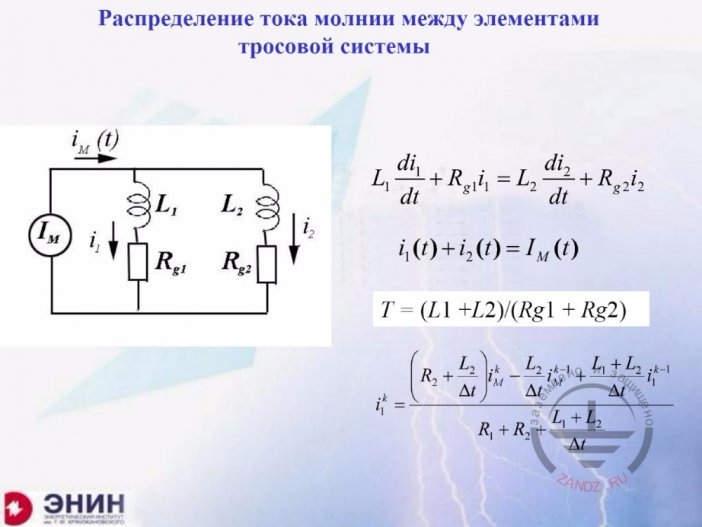
Distribution of lightning current between the elements of catenary wire system
- I'd like to count electromagnetic pickups. For that I need to do the following. I need to count, how lightning current which hits the catenary wire will be distributed if it goes one side from the strike point, to another side from the strike point and if there are neighbouring wires which can have some conductive connections. In this case, the task is solved in equivalent circuits, in which at least the inductivity of wire's parts is taken into account. There can be two of them shown, but there may be more. And the grounding resistance of this wire, that means the task is solved in circuit elements with concentrated parameters. Transient process in this system is solved quite easily and in the result, we get distribution of currents, which can be very different on the left and on the right of wire supports and in ground electrodes.
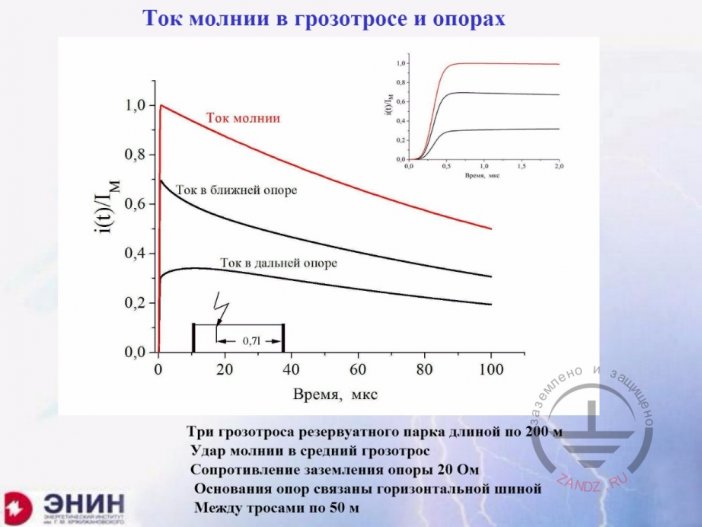
Lightning current in catenary wire and supports
Ток молнии - lighting current
Ток в ближней опоре – current in the nearest support
Ток в дальней опоре – current in the further support
Три грозотроса резервуарного парка длиной по 200 м – 3 ground wires of the reservoir tank 200 m long each
Удар молнии в средний грозотрос – lighting strike into the middle ground wire
Сопротивление заземления опоры 20 Ом – support ground resistance 20 Ohm
Основания опор связаны горизонтальной шиной – Bases of supports are connected with a horizontal bus
Между тросами по 50 м – 50 m is between the wires
- I am giving the example of such distribution for the case of the subsequent lightning component. Why for the case of the subsequent component, because it has the shortest front, the current grows very quickly and the electromagnetic pickup will be the highest. The situation I am examining is as follows. My lightning hit the catenary wire at the distance of 30% of length from one support and 70% from another support. The lightning current itself is shown in red. And this current which flows through the nearest support. Through the nearest support this current will repeat lightning front and the tail will fall a bit quicker.
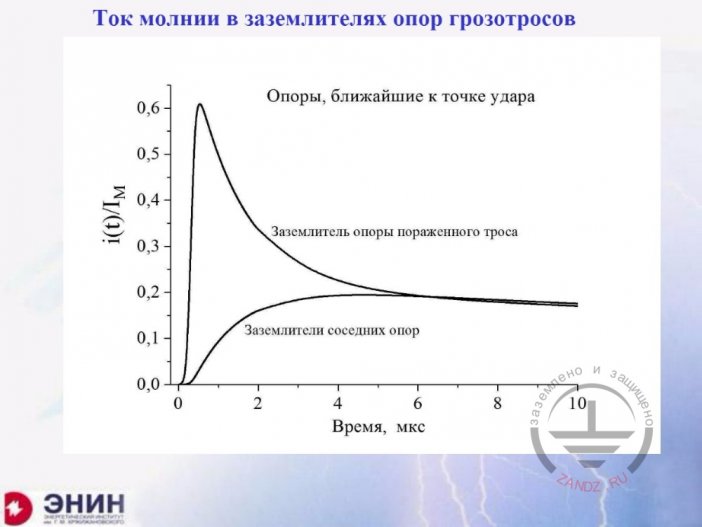
Lightning current in ground electrode systems of catenary wire supports
Опоры ближайшие к точке удара- supports nearest to the strike point
Заземлитель опоры пораженного троса - damaged wire support ground electrode
Заземлители соседних опор – neighboring supports’ ground electrodes
Время, мкс – time, ms
<< Previous Page
Slides from 1 to 8
Next Page >>
Slides from 16 to 24+ questions and answers session
Related Articles:
 Lightning Protection of Large Territories: Parks, Grounds, Plant Territories. Page 1
Lightning Protection of Large Territories: Parks, Grounds, Plant Territories. Page 1
 Lightning Protection of Large Territories: Parks, Grounds, Plant Territories. Page 2
Lightning Protection of Large Territories: Parks, Grounds, Plant Territories. Page 2
 Lightning Protection of Large Territories: Parks, Grounds, Plant Territories. Page 3
Lightning Protection of Large Territories: Parks, Grounds, Plant Territories. Page 3


